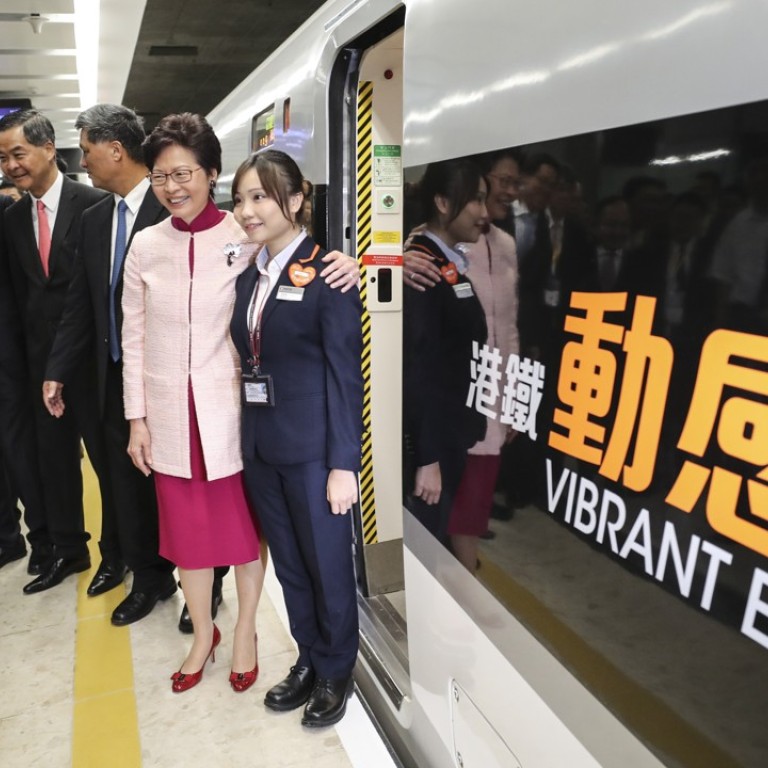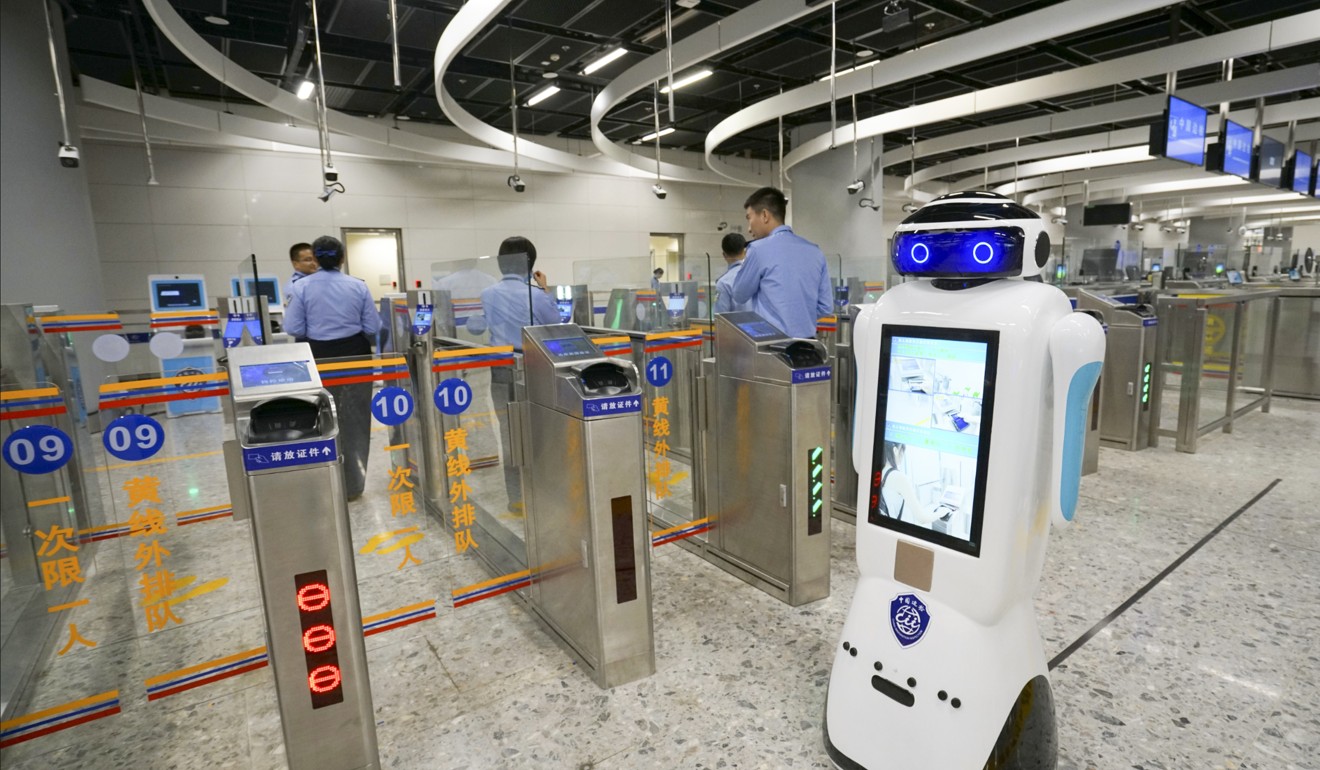
Hong Kong's first high-speed train makes maiden trip across border, as Carrie Lam says rail link will be ‘bright light’ on China’s calling card
Three years late and billions of dollars over budget, express train line to the mainland is finally set to welcome passengers
Hong Kong’s first high-speed train sped off on its maiden journey across the border at 11.26am on Saturday, with the city’s leader declaring that the mega project would be a shining light on China’s calling card.
Chief Executive Carrie Lam Cheng Yuet-ngor gave the ringing endorsement at the HK$84.4 billion (US$11.3 billion) Guangzhou-Shenzhen-Hong Kong Express Rail Link opening ceremony, which was also officiated by Guangdong governor Ma Xingrui, before leading hundreds of guests to board the train.
"We will continue to improve on matters related to railway safety, operation and management, as well as passenger experience, such that the Hong Kong section of the express rail can become a bright light on the country's business card," she said.
The connection between Hong Kong and the mainland's express rail network was now “gapless”, he said. "The commencement of the high-speed rail link significantly shortened the time-space distance between Hong Kong and the mainland.”
Saturday’s event came more than eight years and eight months – or over 3,000 days – after the Legislative Council first approved funding in January 2010. The first trains open to the public are set to start running on Sunday at 7am.
“The most important thing about the commencement of the Hong Kong section of the express railway is linking the people across the border," Lam said.
The most important thing about the commencement of the Hong Kong section of the express railway is linking the people across the border
After the ceremony, Lam and Ma, along with the guests, toured the rail link’s West Kowloon terminus for about half an hour.
When the chief executive reached the border crossing point on level B3 in the station’s mainland port area at 11.15am, she was greeted by a white robot designed to guide travellers on immigration procedures in Cantonese and Mandarin.
The group boarded the train on level B4 at 11.22am, and it set off four minutes later. After arriving in Guangzhou South across the border, she met the city’s mayor, Wen Guohui. Lam and the other guests received a briefing on the railway development in the Pearl River Delta region before boarding the train again to return to Hong Kong.
Speaking to the media upon her return at 1.30 pm, Lam said the non-stop journey to Guangzhou South took them 43 minutes. But the return trip took 48 minutes as the train stopped at Futian station in Shenzhen to drop off some mainland guests.
About 500 guests attended the morning ceremony, including mainland and Hong Kong officials, representatives from the MTR Corporation, and Legco and Executive Council members.
Among those present were Wang Zhimin, head of Beijing's liaison office in Hong Kong and Zhang Xiaoming, Beijing's head of Hong Kong affairs. Sources said Zhang had arrived the night before and had met Lam.

Former secretary for constitutional and mainland affairs Raymond Tam Chi-yuen, who is also an National People’s Congress deputy, said the Hong Kong deputies were discussing travelling to next year's “two sessions” in Beijing – the annual meetings of the NPC and the Chinese People’s Political Consultative Conference – via the express rail.
“I will take the express rail … it is very punctual,” he said.
Democratic Alliance for the Betterment and Progress of Hong Kong lawmaker Vincent Cheng Wing-shun said he would keep an eye on the railway’s operation.
“On operational matters, such as ticketing, there is room for improvement,” Cheng said.
Before the ceremony started, a small group of pro-democracy camp protesters gathered outside the terminus.
“World’s most expensive rail, world’s most useless rail,” they chanted.
Among the protesters was the Civic Party’s Jeremy Tam Man-ho, who had declined to attend the ceremony. He was the only pan-democrat at the protest who had been invited.

Lawmakers Raymond Chan Chi-chuen and Gary Fan Kwok-wai were also at the protest, but they had not been asked to attend the opening ceremony.
Several protesters were dressed in People’s Liberation Army uniforms from the time of late Communist leader Mao Zedong. They said it was to remind people that mainland law enforcement was standing on Hong Kong soil.
“We are Hong Kong people. We should safeguard our city,” one said.
There had been a heavy police presence around the West Kowloon terminus since early Saturday morning, with uniformed officers patrolling inside the station. Police dogs were deployed to search the stage area before the ceremony began at 10am.
Guests began arriving at about 8am, including former officials Elsie Leung Oi-sie and Anthony Cheung Bing-leung, Exco convenor Bernard Chan and member Arthur Li Kwok-cheung. Pro-establishment heavyweights, such as Maria Tam Wai-chu and NPC Standing Committee member Tam Yiu-chung, also arrived well in advance of the ceremony.
Former Hong Kong chief executives Tung Chee-hwa and Leung Chun-ying, were also in attendance.
MTR Corporation top management, including outgoing CEO Lincoln Leong Kwok-kuen and chairman Frederick Ma Si-hang greeted the guests.
The big issues on the express rail link's bumpy ride
NPC Hong Kong deputy Wong Yuk-shan called the express rail link “groundbreaking”.
When asked if he would use the train services for long-haul journeys, he said: “It is more likely I will take the plane – the time is shorter.”
Wong noted it would take about nine hours to reach Beijing via express rail but added that flights were more prone to delays.
The Port Office for mainland China said that its port area inside the terminus was equipped with 30 e-channels and 18 manual check-in channels on each immigration and departure level, mainland media reported on Friday.
The authority also added that the facilities could handle 200,000 passengers daily, and it would take less than 30 minutes for a passenger to complete clearance in the mainland port area.
According to mainland media, the mainland Chinese personnel stationed daily at the joint checkpoint were carefully selected under strict requirements, such as having a good mastery of English and Cantonese. They are required to pass tests after training, on subjects including laws and regulations.

The staff will not leave their designated port area during work or live in Hong Kong. Most of them will commute between Hong Kong and Shenzhen daily by taking the high-speed train at their own expense, excluding a few police officers at the port on overnight duty.
“Officers [working at the port area] would have to [pay for] tickets out of their own pockets and take the high-speed rail in a group to go to work,” Ai Feng, a spokesman for China Immigration Inspection, told mainland media during a tour at the port.
The mainland Chinese employees can eat only take-away food as cooking is not allowed in the mainland port area for fire safety reasons. Catering expenses will be covered by mainland government.

While the original completion date was set for 2015, the project was hit by delays, and the construction costs grew from HK$66.9 billion to HK$88.4 billion.
Apart from issues related to project management, the railway was also embroiled in a political battle between the pro-democracy and pro-establishment camps over its controversial joint checkpoint arrangement.
The so-called co-location arrangement involves giving the mainland a 105,000 square metre area inside the terminus to set up immigration checkpoints – a move that was branded by pan-democrats as “ceding land”.
Inside the area, about 800 mainland officers will be stationed daily to enforce national laws.
Was Hong Kong’s rail line to mainland China worth all the sacrifices?
The government, however, said the arrangement was legal, as it was approved by the National People’s Congress Standing Committee – China’s top legislative body.
To make way for the project, more than 100 residents from Choi Yuen Chuen, a farming village in Yuen Long, had to be relocated.
Additional reporting by Karen Zhang



